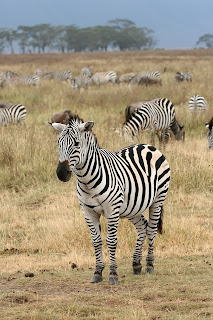A zebroid (also zedonk, zorse, zebra mule, zonkey, and zebrule) is the offspring of any cross between a zebra and any other equine: essentially, a zebra hybrid. In most cases, the sire is a zebra stallion. Offspring of a donkey sire and zebra dam, called a zebra hinny, or donkra, do exist but are rare. Zebroids have been bred since the 19th century. Charles Darwin noted several zebra hybrids in his works.
Zebras (/ˈzɛbrə/ zeb-rə or /ˈziːbrə/ zee-brə)[1] are several species of African equids (horse family) united by their distinctive black and white stripes. Their stripes come in different patterns, unique to each individual. They are generally social animals that live in small harems to large herds. Unlike their closest relatives, horses and asses, zebras have never been truly domesticated.
There are three species of zebras: the plains zebra, the Grévy's zebra and the mountain zebra. The plains zebra and the mountain zebra belong to the subgenus Hippotigris, but Grévy's zebra is the sole species of subgenus Dolichohippus. The latter resembles an ass, to which it is closely related, while the former two are more horse-like. All three belong to the genus Equus, along with other living equids.
The unique stripes of zebras make them one of the animals most familiar to people. They occur in a variety of habitats, such as grasslands, savannas, woodlands, thorny scrublands, mountains, and coastal hills. However, various anthropogenic factors have had a severe impact on zebra populations, in particular hunting for skins and habitat destruction. Grévy's zebra and the mountain zebra are endangered. While plains zebras are much more plentiful, one subspecies, the quagga, became extinct in the late 19th century – though there is currently a plan, called the Quagga Project, that aims to breed zebras that are phenotypically similar to the quagga in a process called breeding back.
The donkey or ass, Equus africanus asinus,[1][2] is a domesticated member of the Equidae or horse family. The wild ancestor of the donkey is the African wild ass, E. africanus. The donkey has been used as a working animal for at least 5000 years. There are more than 40 million donkeys in the world, mostly in underdeveloped countries, where they are used principally as draught or pack animals. Working donkeys are often associated with those living at or below subsistence levels. Small numbers of donkeys are kept for breeding or as pets in developed countries.
A male donkey or ass is called a jack, a female a jenny or jennet;[3][4][5] a young donkey is a foal.[5] Jack donkeys are often used to produce mules.
Asses were first domesticated around 3000 BC,[6] or 4000 BC, probably in Egypt or Mesopotamia,[7] and have spread around the world. They continue to fill important roles in many places today. While domesticated species are increasing in numbers, the African wild ass and another relative, the Onager, are endangered. As beasts of burden and companions, asses and donkeys have worked together with humans for millennia.
A mule is the offspring of a male donkey and a female horse.[1] Horses and donkeys are different species, with different numbers of chromosomes. Of the two F1 hybrids between these two species, a mule is easier to obtain than a hinny (the offspring of a male horse and a female donkey). While there is no known instance of a male mule siring offspring, female mules have on very rare occasion given birth to viable offspring. The size of a mule and work to which it is put depends largely on the breeding of the mule's dam. Mules can be lightweight, medium weight, or even, when produced from draught horse mares, of moderately heavy weight.[2]
It has been claimed that mules are "more patient, sure-footed, hardy and long-lived than horses, and they are considered less obstinate, faster, and more intelligent than donkeys."[3]
A female mule that has estrus cycles and thus, in theory, could carry a fetus, is called a "molly" or "Molly mule," though the term is sometimes used to refer to female mules in general. Pregnancy is rare, but can occasionally occur naturally as well as through embryo transfer. One of several terms for a gelded mule is a "John mule."




No comments:
Post a Comment
Please leave a comment! Tell me how I can make it better!!!